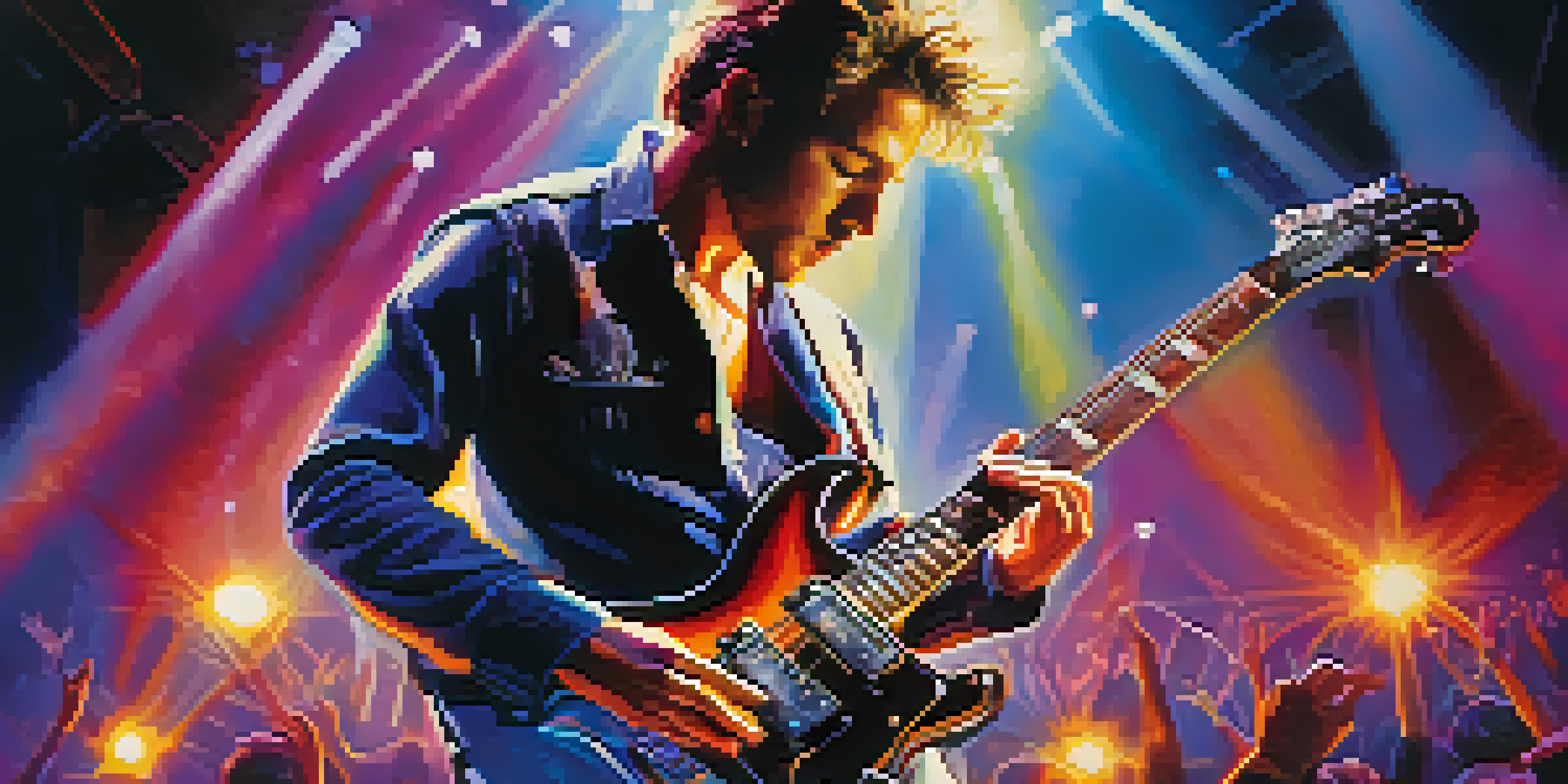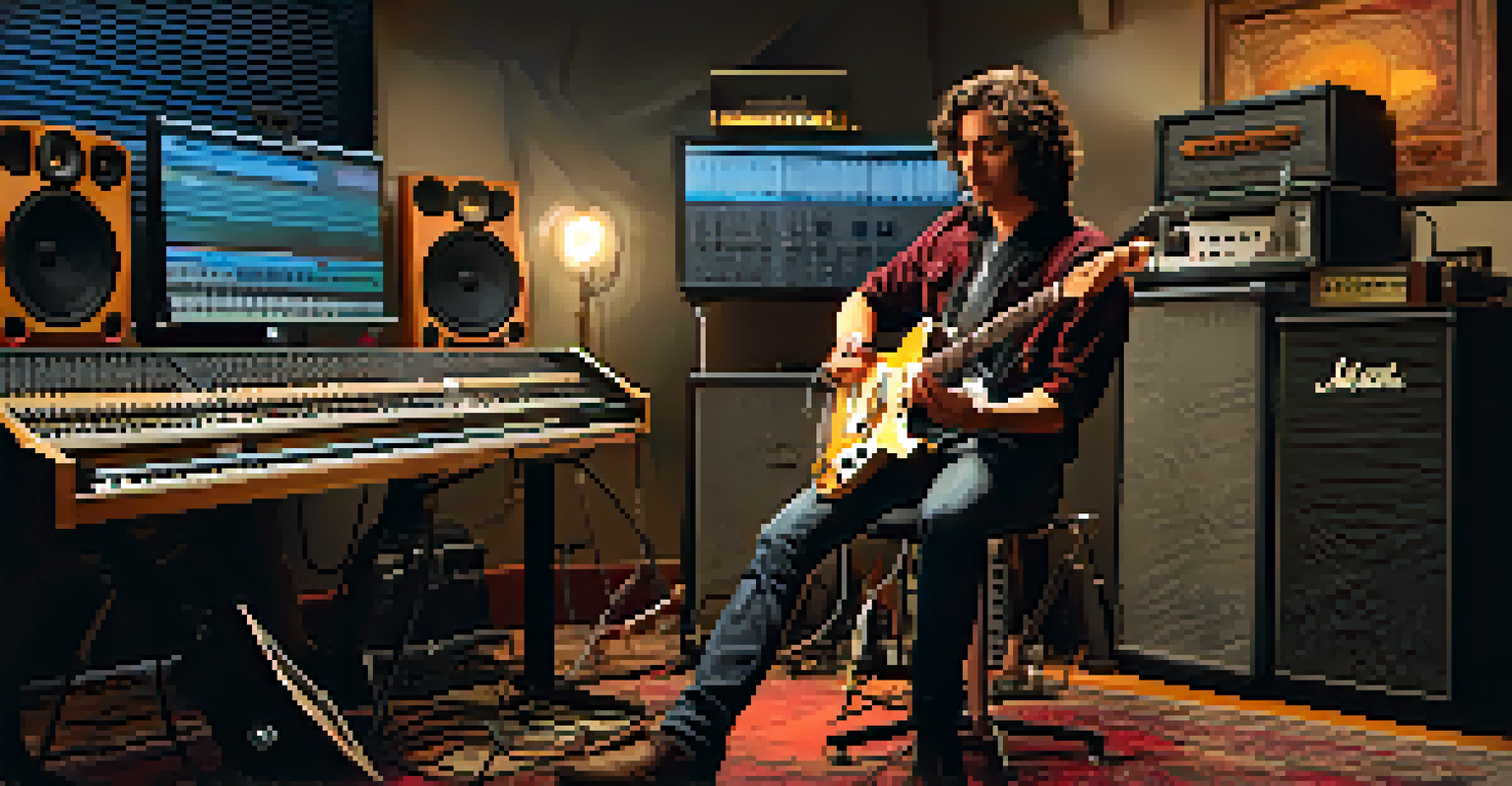The Role of the Lead Guitar in Ensembles Explained

What is the Lead Guitar's Role in a Band?
The lead guitar serves as the primary melodic voice in a band, often responsible for creating the main musical themes. This role is crucial because it adds texture and depth to the overall sound, distinguishing the ensemble's identity. Imagine the lead guitar as the storyteller in a group, weaving narratives through solos and riffs that captivate listeners.
The guitar is a miniature orchestra in itself.
Additionally, the lead guitar often takes on the responsibility of improvisation during performances, showcasing the musician's skill and creativity. This spontaneous aspect not only adds excitement but also engages the audience, making every performance unique. Think of it as a painter adding spontaneous brushstrokes to a canvas, enhancing the emotional impact of the piece.
Ultimately, the lead guitar acts as a bridge between the rhythm section and the vocals, ensuring that the melody stands out amidst the harmony. Its ability to shine while still complementing other instruments is what makes it a vital part of any music ensemble.
The Technical Skills of a Lead Guitarist
A lead guitarist must possess a solid foundation in various techniques, such as bending, sliding, and alternate picking. These skills allow them to express emotion and convey musical ideas effectively. Much like a chef mastering the use of spices, a guitarist uses these techniques to enhance the flavor of their performance.

Moreover, lead guitarists often navigate different genres, from rock to jazz, requiring versatility and adaptability. Understanding each genre's unique characteristics helps them tailor their playing style to suit the band's overall vibe. Picture a chameleon, changing colors to blend seamlessly into its environment—this is how a skilled lead guitarist adapts.
Lead Guitar Adds Sonic Depth
The lead guitar serves as the primary melodic voice in a band, creating themes that enhance the ensemble's identity.
Lastly, a strong sense of timing and rhythm is essential, as the lead guitarist must lock in with the band while also providing melodic highlights. This balance is crucial for maintaining the ensemble's cohesion, ensuring that every note played adds to the collective sound.
How Lead Guitarists Contribute to Songwriting
In many bands, lead guitarists play a pivotal role in the songwriting process, crafting memorable melodies that drive the song. By blending their technical skills and creativity, they can create hooks that resonate with listeners. Think of a lead guitarist as a sculptor, chiseling away at a block of stone to reveal a beautiful statue.
Music can change the world because it can change people.
Furthermore, lead guitarists often collaborate with other band members to develop song structures, harmonies, and arrangements. Their ability to bring ideas to life enhances the creative process and contributes to a more polished final product. Just as a conductor guides an orchestra, the lead guitarist helps steer the band's musical vision.
Ultimately, their contributions during songwriting can define a band's signature sound, making it instantly recognizable to fans. The lead guitar's melodic lines often become the heart of a song, creating emotional connections with the audience.
The Lead Guitar's Interaction with Other Instruments
Collaboration is key in any musical ensemble, and the lead guitarist's interaction with other instruments is vital for achieving a cohesive sound. They work closely with rhythm guitarists and bass players to create a rich harmonic foundation. Picture a well-rehearsed dance routine where each dancer knows their role, complementing each other beautifully.
Additionally, lead guitarists often engage in call-and-response techniques with vocalists, enhancing the overall musical conversation. This interplay can evoke a range of emotions, adding depth to the performance. It's similar to a dialogue between friends, where each person contributes their thoughts, making the exchange lively and engaging.
Technical Skills Enhance Expression
Lead guitarists must master various techniques to effectively convey emotion and adapt their playing style across genres.
Moreover, the lead guitar's ability to blend or stand out as needed creates dynamic shifts within a song, keeping the listener's interest piqued. This versatility is what allows the ensemble to maintain excitement throughout a performance.
The Importance of Stage Presence for Lead Guitarists
Stage presence is an often-overlooked aspect of being a lead guitarist, yet it plays a significant role in engaging the audience. A lead guitarist with charisma can captivate listeners, drawing them into the performance. Imagine a magician on stage; their presence is just as important as the tricks they perform.
This presence can be enhanced through expressive playing, eye contact, and movement, which elevate the overall concert experience. When a lead guitarist fully immerses themselves in the music, it invites the audience to do the same, creating a shared emotional journey. It's like a warm invitation to join a party where everyone is encouraged to dance.
Ultimately, a strong stage presence not only showcases the guitarist's talent but also reinforces the band's brand identity. This connection with the audience fosters loyalty and a sense of community among fans.
Famous Lead Guitarists and Their Impact
Throughout music history, several lead guitarists have left an indelible mark on the industry, shaping the sound of their respective genres. Icons like Jimi Hendrix and Eric Clapton have become synonymous with the lead guitar role, inspiring countless musicians. Their innovative techniques and memorable solos have set standards that many aspire to reach.
These guitarists not only showcased technical prowess but also pushed the boundaries of creativity, experimenting with effects and styles. Their contributions helped to define rock and blues music, making them pivotal figures in music evolution. You could think of them as trailblazers in a vast wilderness, forging paths for others to follow.
Stage Presence Engages Audiences
A strong stage presence not only showcases the guitarist's talent but also fosters a deeper connection with the audience.
The legacy of these musicians continues to influence current lead guitarists, demonstrating the importance of the role in shaping musical culture. When aspiring musicians listen to their work, they don't just hear notes; they feel the passion and artistry that defines great lead guitar playing.
The Future of Lead Guitar in Music Ensembles
As technology advances, the role of lead guitarists is evolving, incorporating new tools and techniques that enhance their performances. Digital effects, loop pedals, and software are becoming integral parts of a lead guitarist's toolkit, allowing for more creativity and experimentation. This shift resembles a painter gaining access to new colors and brushes, expanding their artistic possibilities.
Moreover, the rise of genres like electronic music and hip-hop has introduced new roles for lead guitarists, often integrating them into diverse musical styles. This adaptability is essential in a constantly changing music landscape, allowing lead guitarists to remain relevant. It’s like a surfer riding the waves—those who can adapt to the changing tides often find the best rides.

Looking ahead, the lead guitar will continue to play a vital role in ensembles, blending traditional techniques with modern innovations. This fusion promises exciting developments in music, ensuring that the lead guitar remains a central element of ensemble performances.